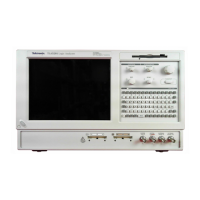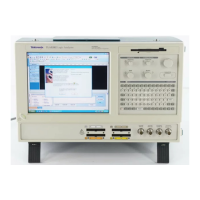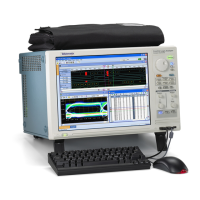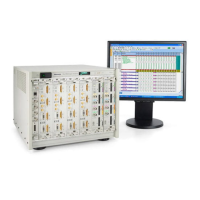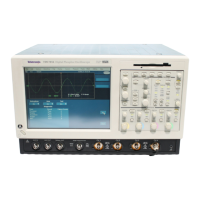Using offset voltage to extend P7700 TDP7700 series solder-in tip input voltage range
The single-ended linear dynamic range of the TekFlex solder-in tip inputs is specified to be 2.5 V
p-p
, which is a range from
-1.25 V to +1.25 V with zero volt offset. The dynamic range of P7700 TDP7700 Series buffers is limited by the input
attenuation factor, which is 2X for the solder-in probe tips as shown in the simplified drawing. See Figure 5: Simplified
drawing of input attenuation factor of the tip buffers on page 25. A 2X 4X attenuation factor was selected for the probe tips
as a compromise between dynamic range and noise, since a higher attenuation factor would have increased probe noise.
Although the dynamic range of the probe tip buffer cannot be extended, it is possible to extend the range over which the tip
dynamic range window can be moved by adjusting the probe offset voltage. The offset voltage range of the TekFlex solder-
in tips is -4 V to +4 V, which is adjusted using the Probe Setup screen of the oscilloscope or the offset knobs on the
oscilloscope front panel. Using the offset voltage controls, it is possible to make measurements within any 2.5 V
p-p
window
between -5.25 V and +5.25 V. For example, by setting the offset voltage to +3.0 V, it is possible to measure an HDMI signal,
which has a signal swing between about +2.8 V and +3.3 V.
Figure 5: Simplified drawing of input attenuation factor of the tip buffers
The offset voltage affects the probe tip buffer’s measured signal through a resistive summer configuration that forms the
buffer’s input attenuator network. The high value resistors used in the buffer’s input attenuator result in an interaction
between the input signal and the offset voltage DC level.
Calibrated offset voltage performance requires that both the input signal and the offset voltage generator in the probe have
a source resistance that is very small compared to the 25 kΩ attenuator resistors. The source resistance of the offset
voltage generator in the probe is less than an ohm. Typically, when the probe and tip are connected to a DUT, the DUT
signals have a source resistance, R
S
, much less than 25 kΩ.
If a TekFlex solder-in tip is attached to a probe but not soldered to anything, the inputs will be open which effectively makes
the source resistance look much larger than the 25 kΩ attenuator resistors. As a result, the offset voltage control is no
longer calibrated and will have 2X their calibrated effect on the measured probe output. This effect can be helpful in
troubleshooting connection issues with the tips. If a probe tip has been soldered to a DUT and adjusting the offset voltage
causes the offset to move 2X the adjustment, it could indicate a broken solder joint that has left the probe tip input open.
Making single ended measurements using the P77BRWSR P77BRWSR differential probe tip
A TriMode tip provides solder connections for a DUT ground reference for both the A and B probe inputs making single-
ended measurements with a TriMode probe tip straightforward. Although the differential input mode of the probe is normally
used to make a differential signal measurement, single-ended measurements can be made using Differential Input mode
when the probe input connections and offset voltage controls are configured properly, This single-ended configuration
process is particularly important to understand when using the tip, since this variable-spacing Browser tip operates only in
Differential Input mode. Differential Input mode provides a measurement of the difference (A – B) between the A and B input
Basic operation
P7700 Series TriMode™ Probes 25

